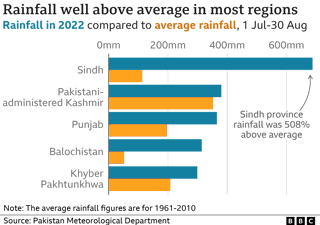Introduction
More than one-third of Pakistan is under water due to unprecedented levels of flooding. Estimates suggest that 1,265 people have been killed, with 6,000+ injured.
The scale of the tragedy is already being compared to the devastating floods of 2010 when more than 2,000 people were killed, marking the event as the deadliest in Pakistan’s history.
There are four provinces in Pakistan: Balochistan, Khyber Pakhtunkhwa, Punjab, and Sindh plus the Islamabad Capital Territory. The Sindh province is bisected by the Indus, Pakistan’s largest river, which flows from the upstream northern highlands of the Himalayas down to the Arabian Ocean.
Glacial meltwater from the Himalayas and Karakoram mountain range plus snow melt and monsoon rains all supply the Indus with water. The Indus is 3,200 km long and has a large discharge of 5,533 m3/s (approximately twice as much as the river Nile in Egypt, placing it 52nd in the world). Flooding often occurs in the southeast of the country, in the Sindh province.

Figure 1 a topographic map of Pakistan, the Sindh provincial capital is Karachi
However, the average discharge for the Indus does not accurately depict the situation in Pakistan because there are extreme spikes in flow, discharge, and flood water at times throughout the year. For example, last week the Indus burst its banks and as much as 17,000 m3/s of water was discharged. This was caused by Pakistan receiving 190% more rainfall from June to August (compared to average rainfall for this time period over the past 30 years).
The Sindh province to the south of the country has been severely impacted, as it has a wide flat central plain (the Indus river valley), covering 51,800 km2.
Sindh province
The main economic industry of Sindh is agriculture, which the Indus river has supported for millennia.
The flow of the Indus is typically high between mid-July and mid-August due to environmental factors. However, this year rainfall in Sindh has been exceptionally heavy in recent months.

Figure 2 rainfall is well above average in most regions across Pakistan © BBC
Is climate change to blame?
Recent heavy rainfall is only part of the story. This flood event is widely being reported as a climate-related disaster due to extreme changes in monsoon behaviour, precipitation patterns, and melting glaciers.
These contributing factors have been accentuated by increases in global temperature. The UN secretary general, António Guterres, emphasised the link to climate change saying “today, it’s Pakistan. Tomorrow, it could be your country” signalling to the world that more needs to be done in the fight against climate change.
The monsoon rainfall was particularly heavy this year due to changes in air temperature across the Arabian Ocean. It is likely that climate change affected the intensity of the monsoon as record amounts of rain fell across the country throughout August (as much as 500-700% more than usual).
The IPCC has reported that South Asia has warmed by around 0.7°C since 1900. This leads to heavy monsoon rain because the warmer atmosphere holds more moisture.
The likelihood of seeing phenomena that may cause severe monsoon conditions is likely to increase. This year, the La Niña event in the Pacific and meanders in the jet stream created perfect conditions for the unusual monsoon rains.
Glacial melt is a growing problem around the world. In Pakistan this is a particular problem as the country has more glaciers than anywhere else in the world, (there are 7,000) excluding the polar regions. This year there has been triple the usual amount of glacial lake outbursts, causing catastrophic flooding.
|
Initial impact |
Short term response |
|
More than 1,265 people have been killed |
The WHO has said that more than 6.4 million people are in dire need of humanitarian aid |
|
A million homes have been destroyed or badly damaged |
The UN has appealed for $160 million (£139 million) to help with what it has called an “unprecedented climate catastrophe” |
|
33 million people have been directly affected |
Aid agencies have asked the government to allow food imports from neighbouring India (the border is normally closed) |
|
Total flood damage estimates exceed £8.7 billion |
The UK government has announced humanitarian support of up to £15 million to help Pakistan's flood response |
|
Sindh, with a population of 50 million, has been hardest hit, receiving 466% more rain than the 30-year average |
A French aircraft carrying relief goods landed in Islamabad on Saturday and was received by the national health services minister Abdul Qadir Patel |
Table 1 a brief summary of the 2022 Pakistan floods
Further work
- BBC Pakistan floods: One third of country is under water - minister
- Publishing Service UK Government Pakistan Toponymic fact file 2019
- Reuters South Pakistan braces for yet more flooding as waters flow down from north
- BBC Pakistan floods: Time running out for families in Sindh
- NASA World of Change: Seasons of the Indus River
- BBC Pakistan floods: Map and satellite photos show extent of devastation
- CNN Pakistan's melting glaciers are 'erupting' and worsening floods
- The Conversation Pakistan floods: what role did climate change play?
